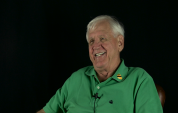6:38 | Bud Alley's best days in Vietnam were the days he returned to find that everyone had made it back alive. He was encouraged by daily correspondence with his family, which he stores chronologically so he can reconstruct his experience. He regrets that he is still seen as a baby killer by some, but he says that the Vietnam vets are the real greatest generation because they had to put up with all that crap. As for the future, stay informed and vote carefully.

Why ROTC? Well, the $27 a month took care of his fraternity dues and his dating money. After graduation, he was informed he was now part of a program that would put him on active duty with no training. Wait, what? As a platoon leader, he caught the eye of a superior and became communications officer.
Most soldiers went to Vietnam on airliners but Bud Alley's unit went the old fashioned way, on a troop ship. After riding out a typhoon, the men anchored offshore and listened to combat communications coming from the battlefield. This hyped up the young recruits who were convinced they were going to storm the beach.
The first thing that hit him was the smell. The place just smelled different. Then he had his first ride on a helicopter, even though his unit was air mobile. At the base camp, it was pup tents in the mud, and a few feet away, the jungle. They had beat the food there, so for a week, it was Saltines and tuna and not a heck of a lot of it.
While setting up base camp, communications officer Bud Alley had to take on extra duty as mess officer, taking over from his friend John Howard. When the commander heard that Alley was asking to go out on combat patrols, he told him to assemble a squad from all the headquarters and support personnel and give the cooks a taste of life outside the wire. He also accompanied medics making sick calls to the local civilians.
The young Lieutenants were bugging the Colonel with their raucous singing so he told them to build an officers' club. Amazingly, it didn't fall over. Bud Alley says that unit cohesion was good despite the disparate races and backgrounds of the men. He had no personnel issues at all in his headquarters unit except one persistent drunk cook.
As head of the communications platoon, Bud Alley assigned his operators to each commander as the unit then began its first big operation, which made him nervous because all the leadership had just been replaced, making it a green unit with all new staff. It was fortunate that the first landing zone was quiet, but there was a lot of noise waiting for them in the Ia Drang Valley. Part 1 of 6.
They heard the action on the radio. Hal Moore's unit had stepped in a hornet's nest at Ia Drang. One by one, their companies were sent into the battle, and eventually, Bud Alley joined them but was frustrated when he was unable to reach the battlefield that first day. On the second day, he ran into his friend George Jennings who had "the stare." Part 2 of 6.
The battle of Ia Drang Valley had subsided and the word came to leave the battlefield, the enemy having apparently vanished. Bud Alley recounts the bad news that piled up, no air transportation, no water resupply and not much time before the B-52 strike right where they were standing. Part 3 of 6.
The enemy was supposed to be back in Cambodia and the column of Americans was snaking away from the Ia Drang battlefield toward landing zones to be picked up. But the men heading toward LZ Albany came under fire from all around. Bud Alley recalls the frightening firefight which ended with him in a ditch listening to the NVA executing the wounded. Part 4 of 6.
The survivors had crawled to the sound of friendly artillery fire and waited for dawn. Bud Alley hailed the men at the perimeter and soon, he and the wounded he had cared for were inside drinking coffee, or trying. Insisting that he report the enemy movements, he and his friend John Howard were flown to brigade headquarters, still bloody and disheveled. To their astonishment, that was more important to the major than their battlefield intelligence. Part 5 of 6.
The aftermath of the battle at Ia Drang Valley was both comical and serious. The comedy was supplied by a wise guy who found a bugle after the battle and sounded off rather artlessly at dawn. That woke up Bud Alley, who crawled out of his foxhole just in time for the Mad Minute rapid fire exercise, which made for more comedy. The serious part was the steep losses and the Army's attempts to keep it quiet. Part 6 of 6.
Bud Alley had one more big operation during his tour and that was Bong San. It started badly, with a plane full of men crashing into a mountain before the maneuver even began. Then, to his astonishment, he was made liaison to the South Vietnamese force. Having survived that, just before his time was up, another bad chain of events began with a new commander asserting his power.
After he returned from Vietnam, there was an airline strike so it took days for Bud Alley to make it home. When he did, he had trouble adjusting to civilian life. Between the nightmares and the drinking, he knew he needed help, but to the VA, he had a haircut and a job so there was nothing wrong with him.